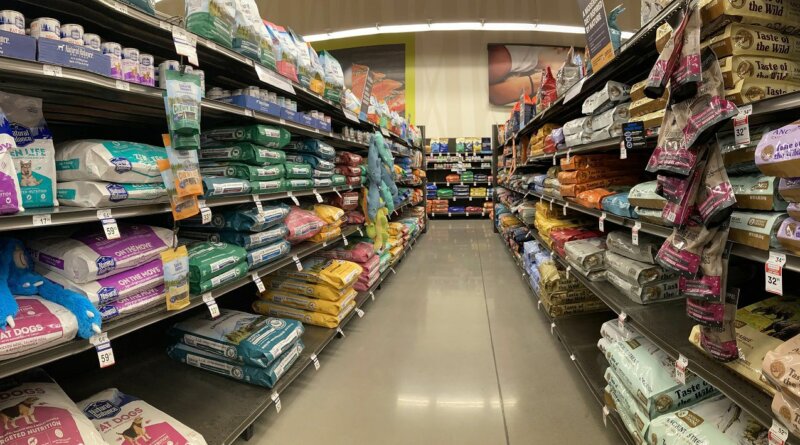Best Dog Food | What To Look For In Dog Food
What’s the best dry dog food? What should I feed my dog? If we had a dollar for every time we’ve been asked those questions, we could retire today!
HALLMARKS OF QUALITY: HOW WE IDENTIFY GOOD DRY DOG FOOD
Here’s what to look for in dog food and the criteria we use to identify good-quality dry dog foods.
- We want to see named animal protein sources at the top of the ingredients list. Ingredients in pet food are listed in order of the weight of that ingredient in the formula, so whatever is at the top of the list is present in the food in the greatest amount.
We want to see animal protein sources, because animal proteins contain more of the amino acids that dogs need than plant-sourced proteins; the more completely a protein provides the amino acids that dogs need, the higher-quality that protein is considered to be.
We also want that animal protein source to be identified by species, whether it’s a meat, organ, or a meat meal.
Meat meals are made through a process called rendering, whereby much of the moisture (and a lot of the fat) is removed from the meat. Meat meals are a highly concentrated source of protein. Pound for pound, meat meals provide much more protein at a lower cost than fresh meats. But fresh meats add appealing flavors and aromas to the food. Also, they get added to the food mixture just before the food is cooked; rendered meat meals have already been processed and will be twice-cooked by the time the food is extruded or baked (nutrients are lost with each cook).
When a fresh meat is first on the ingredient list, there should be a named animal-protein meal immediately or closely following the meat. Fresh or frozen meat contains a lot of moisture (which is heavy), but not that much protein, so if meat is first on the list, it acts like a diluted protein source. That’s why we like to see another named source of animal protein appearing in the top two or three ingredients. We’re emphasizing animal proteins because some companies use fresh meats supported by plant proteins. To repeat ourselves, generally, plant proteins are less complete for dogs than animal proteins.
So, what’s best: meat only, meat meal only, or both? We like both – but it depends on what works best for your dog and your budget.
- We also want to see whole-food ingredients in dog food. When vegetables, fruits, grains, and/or carbohydrate sources such as chickpeas or sweet potatoes are used, they should be whole. Ingredients that have already been processed, shipped, and stored before they are used in pet food will have lost quite a bit of their nutritive value before they are mixed with other ingredients and processed again (mixed with other ingredients and then either baked or extruded, dried, and coated).
- As icing on the cake, we look for ingredients that are certified as organic, humanely raised, or sustainably farmed. Companies will use wiggle words to lend the impression that they are using the best ingredients available. Certifications give these claims credibility.
SUBSCRIBERS ONLY: Click here to see Whole Dog Journal’s 2022 list of approved dry dog foods.
SIGNS OF LOW-QUALITY DOG FOOD: TRAITS AND INGREDIENTS TO AVOID
The following are traits that we don’t want to see on a dog food label – undesirable attributes that indicate a lower-quality food:
- The lowest price you can find. The cheapest foods contain the cheapest ingredients available to pet food manufacturers. While technically any food that’s labeled as “complete and balanced” is supposed to contain minimum amounts of the nutrients dogs need, with low-quality ingredients, there is no telling how bio-available the nutrients will be.
- Animal products that are not specified by species. Meat meal, meat and bone meal, poultry meal, poultry by-product meal, animal fat, poultry fat: If you have a pet with a food intolerance or allergy, you have to know what you’re feeding him in order to identify the problematic ingredient.
- Animal by-products. This includes meat by-products and poultry by-products, as well as meat by-product meal and poultry by-product meal. These animal protein sources are nutritious, but are handled with far less care than more expensive animal protein sources (i.e., without refrigeration and with less sanitation).
We’d choose a food that contained meat by-products over one with meat by-product meal; the unrendered ingredients must be used for food production quickly, whereas the industry handles ingredients that are going to be rendered with less urgency. Also, again, all meals have been cooked once already and will be cooked again after being mixed with all the other food ingredients.
- Added sweeteners. Like us, dogs like sweets. But they also like meat, especially fatty meats. When a food lacks enough meat to make it appealing to dogs, either because the food is carbohydrate-heavy or uses mostly plant-sourced proteins, sweeteners are often added to increase the food’s palatability.
- Artificial colors, flavors, or preservatives (such as BHA, BHT, ethoxyquin). The color of the food doesn’t matter to your dog. And it should be flavored well enough with healthy meats and fats to be enticing. Natural preservatives, such as mixed tocopherols, are healthier than synthetic preservatives.
The one time we don’t mind seeing an artificial preservative is in foods that contain a lot of fish. Fish and fish meals are notoriously volatile; the fats in fish go rancid more quickly than other animal fats. Artificial preservatives repress the rancidity better and longer than natural preservatives. Pro tip: If buying a fish-based food, check the date-code on the bag and try to get the freshest food possible.
- Ingredient splitting. This is where two or more very similar food “fractions” appear separately on the ingredients list. A pet food manufacturer can use this technique to make it appear that a high-quality ingredient is represented in the food in a greater proportion than it really is. Remember, the food’s ingredients are listed in descending order of their weight on the label. By using several separate iterations of an ingredient and listing them separately, they will fall below the better ingredient on the ingredients list.
An example: A label lists chicken meal first on the label, followed by several fractions or versions of an ingredient as separate ingredients (i.e., rice, brewer’s rice, rice bran, rice protein meal). If all the iterations of the “rice” ingredients were combined or reconstituted, they would outweigh and push the chicken down on the ingredients list; it would now read rice first, then chicken.
‘Complete’ But Not Equivalent: Comparing Similar Products
Many people (and even many veterinarians) believe that all foods that are labeled as “complete and balanced” contain approximately the same amounts and levels of nutrients. This presumes that pet food makers are all working to meet some sort of “recommended daily allowance” (RDA) of nutrients required by dogs – but it’s not true.
The RDA nutrient levels for humans were developed by the Food and Nutrition Board of the National Research Council/National Academy of Sciences. Vitamin, mineral, and macronutrient (fat, protein, carbohydrate) levels are expressed on our food packages as providing some percentage of the total amount of various nutrients that we need daily. But this isn’t how nutrient levels in pet foods are expressed.
The Association of American Feed Control Officials (AAFCO) establishes the nutrient levels that legally constitute “complete and balanced” diets for our pets, and publishes the requirements for canine diets in a table – the “AAFCO Dog Food Nutrient Profiles.”
But, unlike the human RDAs with target levels of nutrients, the Dog Food Nutrient Profiles consist only of minimum values for all the nutrients required by dogs and maximum values for just a few nutrients. As long as a food meets the minimum nutrient values expressed in the profiles, and doesn’t exceed the maximum values, it can be labeled as “complete and balanced.”
Let’s say it another way: The foods on your pet store shelves may actually contain wildly varying levels of vitamins, minerals, and macronutrients, and yet all can call themselves “complete and balanced.”
All of the chicken- and rice-based foods below are labeled as “complete and balanced” diets for adult dogs; each purportedly meets the minimum nutritional standards for the “maintenance” of adult dogs. But we can’t possibly consider these foods as equivalent. We’ve listed the first 10 ingredients from their labels so you can compare the formulas. We’ve also positioned them in order of decreasing quality – from first to worst – in our opinion and according to our selection criteria.
YOUR DOG’S NEEDS WHEN PICKING THE BEST DOG FOOD
By applying the foregoing criteria, we’ve found a thousand or more good foods to choose from; their manufacturers appear on our “Approved Dry Dog Foods” list. But we know what you’re going to ask next: How do you choose some for your dog?
The answer depends on what you’re feeding your dog now and what he looks and feels like.
If he looks like a show dog (he’s at an appropriate weight and has a glossy coat and clean ears), he seems to feel good (he’s energetic without being hyperactive, he’s not itchy, and his appetite is good), and his poop is a good density (not too loose nor too hard), what you’re feeding him now is likely working just fine! Good job!
But if he’s too fat or too thin, his coat is without luster, he’s itchy and prone to ear infections, is constantly licking his paws or developing hot spots, lacks energy or is reactive and hyperactive, or has chronic diarrhea or constipation, then it’s time to change his food.
What you change it to depends on what changes you want to make in your dog:
- If he’s overweight, you need to reduce the number of calories he receives; a food with less fat and higher-quality protein sources is in order.
- If he’s too thin and you haven’t been able to get him to gain weight, a food with higher amounts of fat and high-quality protein in order.
- If he’s itchy year-round, he likely has allergies. You need to conduct a food elimination trial, to try to determine what ingredients he may be allergic to, so you can avoid those ingredients. At the very least, select a “limited-ingredient” food, one that contains just one species of animal protein and as few other ingredients as possible. Make notes daily about your dog’s itching; is it more or less frequent when you feed him a chicken-based diet than when he’s on a lamb-based diet?
Since most food allergies involve proteins, try to find a food that uses only one species of animal protein, and a single grain or carb source. Grains and legumes also contain protein, so these need to be considered as potential allergens as well.
- If he has digestive issues, he may need more fiber in his diet, or the right kind of fiber. Soluble fiber, found in oat bran, beans, lentils, chickpeas, and peas, slows things down in the digestive tract, helping relieve chronic diarrhea. Insoluble fiber, found in wheat bran, vegetables, quinoa, and whole grains, helps speed up the transit of food in the digestive tract and helps prevent constipation.
Some food ingredients, including most legumes, contain both soluble and insoluble fiber.
SUBSCRIBERS ONLY: Click here to see Whole Dog Journal’s 2022 list of approved dry dog foods.
TWO MORE FACTORS WHEN CHOOSING THE BEST DOG FOOD
What if your dog is just fine – maybe not ready for a show ring, but without any notable problems, either. How should you select a food in that case?
- One obvious factor to consider is cost. Better-quality foods are considerably more expensive than low-quality foods. The size of your dog, and how many dogs you have, may affect your selection.
Keep in mind that the most expensive food is not necessarily the best food. High sales prices don’t always reflect the quality of the food ingredients. Keep in mind that some pet food companies maintain large research facilities; others spend a huge amount on advertising and/or sponsorships of dog-related events.
That said, we must warn you away from the lowest-cost foods. Most of them are more suitable for feeding birds than dogs.
- Make sure to check the nutritional adequacy statement (better known as the AAFCO statement) on the label to make sure you are buying a food that’s formulated to meet your dog’s needs. It’s one of the most important bits of information about the food, and yet it’s almost always listed in very tiny print.
The statement tells you which set of nutritional requirements the food meets: the standards for “growth” (puppies and pregnant or nursing females) or “adult maintenance.” Those two descriptions are sometimes referred to as “life-stage foods.” This is not to be confused with foods for dogs “of all life stages,” which means that the food has been formulated to meet the requirements of dogs of any age or life stage.
Some companies also offer what they call “senior” foods, but there are not different standards for senior dogs; check the AAFCO statement to see if the food was formulated to meet the requirements for adult maintenance or all life stages.
- The energy density of the food – how many calories it contains – is something else to consider. Say you’ve been feeding a product with 300 calories per cup, and your dog, who’s at a healthy weight, gets two cups a day. If you switch to a food with 400 calories per cup, and you keep feeding him two cups a day, you will be giving him 200 more calories a day more than you were. He won’t stay at that ideal weight for long, unless you reduce the amount you feed, in this case, to a cup and a half. Will feeding him 25% less than you were previously leave him hungry and disgruntled, leading him to raid the cat food and counter-surf? He may be better off with a lower-calorie food.
SUBSCRIBERS ONLY: Click here to see Whole Dog Journal’s 2022 list of approved dry dog foods.






men’s ed pills: cheap ed drugs compare ed drugs
best erectile dysfunction pills https://edpill.pro/# – best otc ed pills